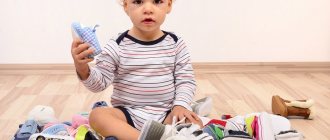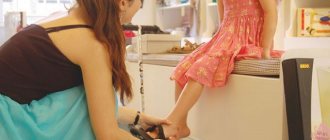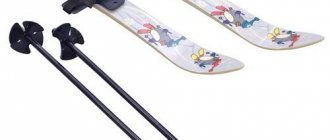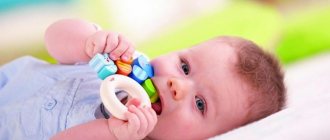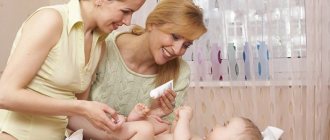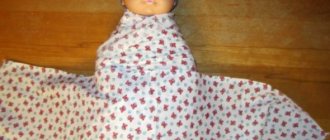Oddly enough, children do not feel pain if they walk in tight shoes. This is due to the fact that their feet contain a sufficient amount of fatty tissue, which dulls the pain. But for growing feet, the correct selection of shoes is of great importance.
An improperly formed arch of the foot is not only a cosmetic defect. In the future, this can cause serious problems with the baby’s health, because poor posture and scoliosis often develop due to improper gait and flat feet.
An inconvenient last, unsuitable heel, material and many other mistakes are very fraught. Let's look at the basic rules for choosing shoes for a baby.
Size
The task is complicated by the fact that you have to buy shoes quite often - after all, your feet are growing. Here extremes are inappropriate: shoes purchased “true to size” will quickly become small, and your toes will have to be curled. But shoes taken with a large supply are also not a solution - the foot will slip in them, it will be hard and uncomfortable for the child, and the likelihood of injury will also increase. The joint ligaments in childhood are very weak, so if the shoes do not secure the foot, sprains, subluxations and dislocations of the joints easily occur when falling. Remember the rule - the margin should be about one and a half centimeters (for winter shoes a little more per sock).
How to choose shoes for a child
We offer you 7 practical tips on how to choose shoes for your child.
Flexible sole
The grooved surface gives flexibility to the sole. Flexibility in the forefoot of the shoe is of greater importance for the formation of the correct walking mechanism. Otherwise, the shock absorption protection may decrease and the load on the foot may increase, resulting in a rolling gait.
Shoe weight: light materials, removable insoles
The lightness of the first shoes is of paramount importance . Since the baby is just learning to take his first steps, heavy shoes can significantly complicate the learning process. A special feature of a child’s foot is quite profuse sweating; there are more than 200 sweat glands per 1 square centimeter in the foot.
It is important that the insoles are removable with the ability to dry both the insoles themselves and the shoes inside.
To dry, it is better to place a ball of paper inside; drying directly near a heat source is not recommended, as this can lead to deformation of the shoes. In Primigi shoes, lightweight removable insoles are made using SKY EFFECT SYSTEM technology and covered with leather, which gives the child a feeling of natural comfort.
Ergonomic shape: free front part, fullness adjustable
A child's foot is characterized by a narrow heel and a wide forefoot. For a comfortable feeling and proper development of the foot, it is important that the front part of the foot is not compressed and the baby can move his toes freely.
Pay attention to the ergonomic shape of the baby's shoes. The fullness of children's feet can vary significantly, so shoes must be able to be adjusted in fullness: Velcro, laces and buckles allow you to adapt the shoes.
Solid high back
For the correct development of the foot and the prevention of plano-valgus deformity and flat feet in the future, correct placement of the heel and fixation of the ankle joint is important. That is why it is not recommended to wear shoes with a soft back or without a back that do not secure the ankle joint.
Do not buy flip-flops, house slippers, sandals with a strap on the heel, or winter shoes without a hard back for your children. Shoes for children under 3 years of age must have a hard heel.
Inner sole shock absorber
The baby's feet encounter uneven ground, micro-collisions that occur when jumping and walking can be absorbed by the internal shock absorber of the Anti-Shock sole. Anti-shock is an air space in the sole that cushions and eliminates microshocks , protecting the baby’s foot.
Waterproof and breathable material
For the first shoes, the materials from which the shoes are made are important. The CORE-TEX technology in Primigi shoes allows the shoe to be both waterproof and breathable .
This is a special membrane with 1.4 billion pores per 1 square centimeter, which is located between the lining and the top layer of the shoe. Pores are 20,000 times smaller than water molecules, but 700 times larger than water vapor molecules. This is why water cannot get inside, and sweat comes out easily.
And Primigi CORE-TEX SURROUND technology provides an open sole structure, making the shoe completely waterproof and breathable. This is especially important during seasons when the weather often changes from sunny to rainy and vice versa.
Safety
Natural materials, no nickel in metal elements, no chromium in the inner lining material.
Shoes come into close contact with the baby's skin through a thin sock; in warm and humid conditions, harmful substances can get on the baby's skin. The naturalness of materials for shoes is not subject to discussion: genuine leather and textiles are traditionally considered the best materials for children's shoes.
The lining material should not contain chromium , which can cause irritation to the skin of the feet. Many children have an allergic reaction to fastener elements and decorative elements containing nickel.
The main criteria for the right shoes: flexibility, lightness, breathability, strength, softness - the principles of the Primigi system.
Do you need an instep support in your first shoe?
Many mothers have the opinion that for the first shoes it is extremely important to have an instep or arch support to prevent the formation of a flat foot. As we wrote above, in children the role of a shock absorber is performed by a fat pad , which fills the arch and protects the child’s foot from stress.
The presence of an instep support in the first shoe helps to erase the fat pad and weaken the protection of the foot . Exception: recommendations of an orthopedist for serious signs of pathology of the child’s foot formation.
The second important fact is that the arch support must be located in a strictly defined area of the foot, otherwise it will interfere with the blood circulation of the foot and cause discomfort in the child.
Therefore, it is worth talking about individually selected shoes or special orthopedic insoles; the correct location of the instep support should be adjusted by an orthopedist every 3-4 months.
Fitting
It is convenient to have with you a “footprint” of the baby - his leg circled on cardboard. With it, in principle, you can choose shoes quite accurately even without a child. But even if your child is with you, this will allow you to reject many unsuitable options without trying them on, which will save you a good mood and time. When actually trying on, it is important to pay attention to the following:
- Is it comfortable to wear this pair;
- You need to measure shoes on both feet;
- look at the baby’s gait to see if it has changed.
How to choose shoes for your child according to the season
- Winter: During the cold season, it is recommended to have at least two pairs of shoes. One pair for the street: high insulated boots, boots with a hard back, thick but flexible soles. Second pair: for heated visits: at home, away. These can be light boots or sandals with a high hard back, made of natural materials.
- Spring and autumn: Autumn lightweight boots made of light leather with inner inserts made of thicker leather. During this period, boots with a CORE-TEX membrane from Primigi will be comfortable; the baby's feet will always remain dry thanks to the waterproof and breathable properties of the shoes.
- Summer: Up to 2 years old, light sandals with a high hard back, closed wide toe part, adjustable in fullness with fasteners, Velcro or laces are suitable. For children over 2 years old, you can also choose sandals with a more open toe part; Velcro is more suitable here so that the child can put on the shoes himself.
Sole
The following requirements are imposed on the sole: it must be flexible, grooved and non-slippery. Previously, leather soles were popular, but nowadays such soles are practically not made, since they are quite hard. The shock-absorbing function of the foot depends specifically on the sole, because if it does not bend, then a normal roll from heel to toe is impossible. Try bending the sole with your hand, it should work. As a last resort, if the sole is still hard, the toe should be pulled up strongly, then although the sole will not be able to repeat the movements of the foot, rolling from toe to heel will be possible.
Heel
On the heel side, the sole should be 1-1.5 centimeters higher.
A separate conversation about heels for little ladies. Of course, their dream of looking older and clicking their heels is understandable. Moreover, in our time there is no strict control over the quality of cheap children's goods imported into the country, and you can often find beautiful little shoes with fairly decent unacceptable heels. The eyes of the little fashionista light up, the mother is lost... It is very important not to be led by children’s fantasies, to explain to the child why this is dangerous in the future.
Sometimes it is necessary to hold educational programs at parent-teacher meetings in kindergartens and primary schools so that parents have unity and children do not take bad examples from each other.
How a child's foot is formed
In the first years of life, a child’s foot goes through several stages of development:
- In the first 8-9 months of a baby’s life, the feet do not yet feel the weight of the body , which is why children typically lack an arch. The arch of the foot begins to form only after the start of walking; in the future, it will help distribute the weight of the body and acts like a spring, softening the shocks of the body.
A feature of a newborn’s foot is also the relative mobility of the big toe ; during this period of time, it resembles the function of the thumb on the hand. As a person grows, unlike monkeys, he loses this ability.
- With the first steps , the foot begins to feel the weight of the body on itself, the ligaments and muscles of the foot are strengthened. The arch of the foot will be absent in the baby until the age of 2.5-3 years.
In fact, there is an arch, it is formed by the position of the bones and cartilage of the child’s foot, but it is filled with a dense fat pad, it is this pad that acts as a shock absorber in children under 5-6 years old. Therefore, feet will be flat until this age .
This is the norm! During this period of time, it is important to fix and correctly position the heel to prevent it from falling: a high solid heel, high fasteners.
- At the age of 3 to 8 years, the arch of the foot is actively developing; after 7 years, with signs of the formation of a flat foot, the need for an arch support .
There is a simple diagnostic technique to determine whether there is cause for concern: if the baby stands on his toes and the arch of the foot appears, then there is no cause for alarm.
If the feet remain flat in all positions, discomfort, pain, and limited mobility appear - you should definitely see an orthopedist.
The doctor, in turn, will determine whether there is a need to wear special orthopedic structures, orthopedic shoes, insoles, or in severe cases, surgical intervention.
Second hand
Not only is it unacceptable to buy second-hand goods, but also to use children’s shoes inherited from older brothers and sisters in the same family. This is due to the fact that even with excellent external qualities, individual deformation always occurs in worn shoes, and the shoes do not perform the function of holding the foot in the correct position at the proper level.
Well, arm yourself with our advice, and let your children’s shoes be just the right ones!
Article provided by the website Detsky Sad.ru
